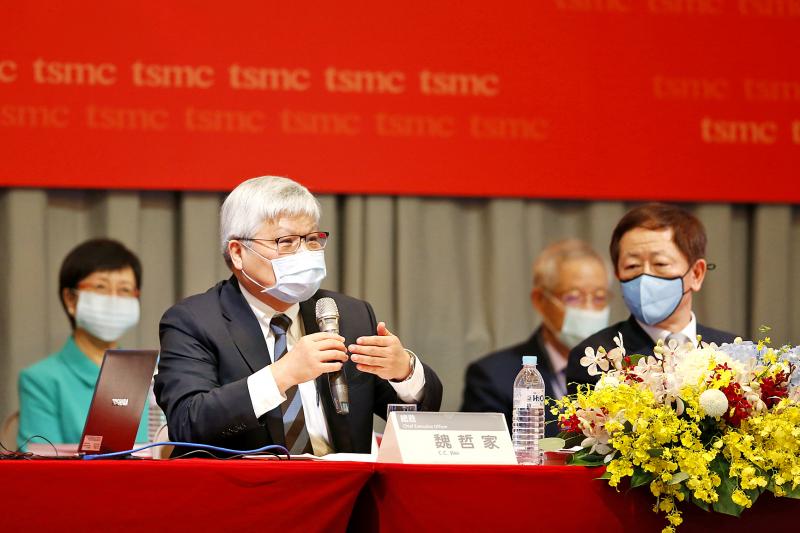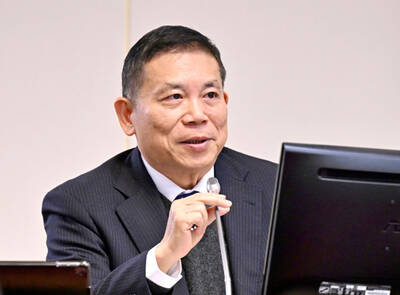Taiwan Semiconductor Manufacturing Co (TSMC, 台積電) yesterday left its record capital expenditures plan unchanged for this year as robust client demand for 5-nanometer technology is expected to quickly fill a capacity hole after the US government announced restrictions against supplying Huawei Technologies Co (華為).
The world’s biggest contract chipmaker had said that it planned to spend between US$15 billion and US$16 billion this year primarily to expand capacity for advanced 5-nanometer and 7-nanometer technologies, and develop 3-nanometer technology.
“It looks like we will see a hole in demand for 5-nanometer capacity this year, but I believe this hole will soon be filled,” TSMC chairman Mark Liu (劉德音) told a media briefing after the company’s annual shareholders’ meeting in Hsinchu.

Photo: Ashley Pon, Bloomberg
If HiSilicon Technologies Co (海思), a semiconductor arm of Huawei, cancels orders, TSMC’s other clients would make up for that lost capacity, as they have approached the company about placing orders, Liu said in response to shareholder concern that the US’ latest chip supply restrictions on foreign chipmakers might put a damper on TSMC’s revenue growth.
TSMC’s 5-nanometer technology is the most advanced technology available, and HiSilicon, Apple Inc and Advanced Micro Devices Inc are typically early adopters of the company’s most advanced technologies.
“We are not going to alter our capital spending for this year, nor are we going to revise our revenue growth outlook for this year,” Liu said.
However, he said that the chipmaker is facing challenges due to US-China trade tensions.
TSMC in April slightly trimmed its revenue growth for this year to an annual expansion of 15 to 18 percent, down from a previous forecast of more than 17 percent, as the COVID-19 pandemic dampened demand for smartphones.
The pandemic has not sidetracked the chipmaker’s upgrade to 5-nanometer and 3-nanometer technologies, Liu said.
Mass production of 3-nanometer technology would start as planned in the second half of 2022, with 4-nanometer technology, an enhanced version of 5-nanometer technology, being mass produced in 2023, Liu added.
Officials also discussed a plan to build a US$12 billion fab in Arizona, as shareholders expressed concern that the investment would weigh on profitability.
Subsidies from the US federal and state governments would be a determining factor in the final decision to build the fab, Liu said, adding that TSMC has not yet signed a formal agreement with US authorities.
“If the US [federal and state] governments are willing to cover our running costs, our profit margin will not be affected,” Liu said.
In such a case, the Arizona fab would definitely make a profit, as its gross margin would be similar to that of the corporate level of the company, he said.
TSMC said that the US subsidies are a crucial component of its plan to construct the fab, adding that it hopes subsidies would make US manufacturing costs comparable to those in Taiwan and China.
The firm’s raw material suppliers, such as chemicals and special gas companies, also plan to build production lines in Arizona, where Intel Corp and several other semiconductor firms have built a solid supply chain, Liu said.
TSMC shares yesterday closed up 0.31 percent at NT$319 in Taipei trading.

UNCERTAINTY: Innolux activated a stringent supply chain management mechanism, as it did during the COVID-19 pandemic, to ensure optimal inventory levels for customers Flat-panel display makers AUO Corp (友達) and Innolux Corp (群創) yesterday said that about 12 to 20 percent of their display business is at risk of potential US tariffs and that they would relocate production or shipment destinations to mitigate the levies’ effects. US tariffs would have a direct impact of US$200 million on AUO’s revenue, company chairman Paul Peng (彭雙浪) told reporters on the sidelines of the Touch Taiwan trade show in Taipei yesterday. That would make up about 12 percent of the company’s overall revenue. To cope with the tariff uncertainty, AUO plans to allocate its production to manufacturing facilities in

Taiwan will prioritize the development of silicon photonics by taking advantage of its strength in the semiconductor industry to build another shield to protect the local economy, National Development Council (NDC) Minister Paul Liu (劉鏡清) said yesterday. Speaking at a meeting of the legislature’s Economics Committee, Liu said Taiwan already has the artificial intelligence (AI) industry as a shield, after the semiconductor industry, to safeguard the country, and is looking at new unique fields to build more economic shields. While Taiwan will further strengthen its existing shields, over the longer term, the country is determined to focus on such potential segments as

TAKING STOCK: A Taiwanese cookware firm in Vietnam urged customers to assess inventory or place orders early so shipments can reach the US while tariffs are paused Taiwanese businesses in Vietnam are exploring alternatives after the White House imposed a 46 percent import duty on Vietnamese goods, following US President Donald Trump’s announcement of “reciprocal” tariffs on the US’ trading partners. Lo Shih-liang (羅世良), chairman of Brico Industry Co (裕茂工業), a Taiwanese company that manufactures cast iron cookware and stove components in Vietnam, said that more than 40 percent of his business was tied to the US market, describing the constant US policy shifts as an emotional roller coaster. “I work during the day and stay up all night watching the news. I’ve been following US news until 3am

COLLABORATION: Given Taiwan’s key position in global supply chains, the US firm is discussing strategies with local partners and clients to deal with global uncertainties Advanced Micro Devices Inc (AMD) yesterday said it is meeting with local ecosystem partners, including Taiwan Semiconductor Manufacturing Co (TSMC, 台積電), to discuss strategies, including long-term manufacturing, to navigate uncertainties such as US tariffs, as Taiwan occupies an important position in global supply chains. AMD chief executive officer Lisa Su (蘇姿丰) told reporters that Taiwan is an important part of the chip designer’s ecosystem and she is discussing with partners and customers in Taiwan to forge strong collaborations on different areas during this critical period. AMD has just become the first artificial-intelligence (AI) server chip customer of TSMC to utilize its advanced